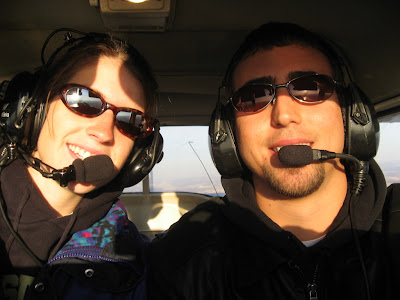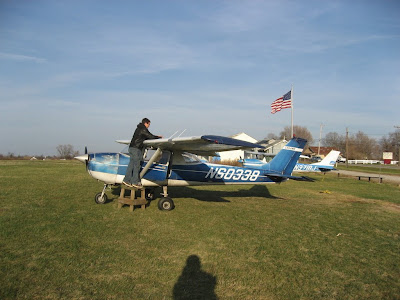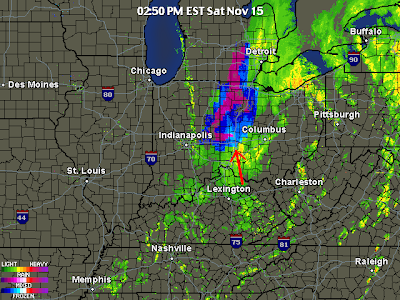Plane: Cessna 150
Route: (40I-) MGY-I19-MGY
Weather: Overcast, 28 degrees, wind 200 degrees at 6 knots
With 269 landings, five months of training, nearly 75 flight hours, plenty of frustration, tons of fun, at least $6000 spent, and so many great memories behind me... I'm a Private Pilot! The weather cooperated and I went up with the examiner to complete the flying portion of my checkride, following last weekend's
oral exam. Everything went well and I didn't feel any nerves aside from a little hope that I wouldn't make any boneheaded mistakes. Luckily, I did not. I am now the proud holder of a Temporary Airman Certificate, good until my plastic FAA certificate arrives in the mail.
As I did with the oral exam, I'll share the details of the checkride below. And make sure you read the end of the post, as I got to deal with some serious craziness when I went to leave Wright Brothers.
- I arrived at Stewart early in order to get a weather briefing, compute my weight and balance, and make sure I had all the paperwork in order. Then I had some help in starting the plane (it takes some extra work when it's 15 degrees out at night - brr!) and I let it warm up for a couple minutes. Fuel full, I left around 12:15 and got in a few practice landings at Wright Brothers before my scheduled 1:00 appointment with the examiner. Having not practiced a no-flap landing, I made one there and it was incredibly smooth. My landings felt great last night and today, hopefully a good sign for today.
- After a quick look through my papers, we walked out to the plane and he asked me to do a preflight as if it were the first flight of the day. I walked around the plane and made my usual inspection, mentioning what I was doing on a couple occasions but for the most part not saying much. It looked like the examiner was just looking over to make sure I checked everything important. He told me he was going to get into the little 150 when I was about 2/3 of the way through the inspection. Both in the plane, I went through the pre-start checklist and got the engine running. He told me that I was PIC (Pilot in Command) so I would be responsible for the flight and should call out all traffic to him. I ran through the CIGAR checklist on the ramp (minus the runup) and then taxied down to the runup area at the end of the runway. During the runup I called out as I checked the suction (which I do even when I fly solo) and mags "left, drop, both, right, drop, both..." and declared us ready to fly.
- He asked me to make a normal takeoff and then proceed on course, which was about due East to our destination in Clarksburg, WV. The takeoff was very smooth and I got to pattern altitude and turned downwind. He asked what the heck I was doing. Crap, stupid move there. I should have departed on a 45 degree heading from the takeoff runway and instead flew downwind for some stupid reason. We do use that departure at Stewart sometimes, but honestly I just totally didn't have my brain connected. No big deal, he just explained to me the reasons for specific departures and I overflew the airport and then departed on the proper 155 degree heading. Phwew.
- Leveling off at 3,500 feet, he said I should pitch over and build up speed before pulling back the throttle. I don't know if I was taught to throttle back while leveling off or if I just invented the habit on my own, but a good idea that I'll use in the future. We were about due South of Xenia at this point (meaning we had traveled all of 10ish miles) and he had me descend to 2,500 feet and divert to Green County Airport (I19). I know you never fly much of the cross-country you plan for the checkride, but that sure was short.
- Using my sectional, I found the frequency for I19 and entered the pattern on a 45 degree entry. He asked for a normal landing so I set up for that, starting the descent abeam the numbers on downwind. I've heard from local pilots the winds are interesting on Runway 25 because it's at the edge of a 100 foot slope down to a road and gravel pit. I anticipated that on short final but I didn't feel much. The landing was smooth but as soon as I touched down he jerked the yoke and said to get the ailerons into the wind, which was about 4 knots and 20 degrees off the nose. Doesn't seem like much but he said a lot of pilots have had the wing get under their wings because they don't think a light crosswind can do anything. Point noted sir.
- Short field takeoffs and landings were next. The takeoff went great and I set up for an extended downwind for the landing. He told me to name my point and I said I'd touch down on the numbers. I ended up landing within a few feet of the numbers, although it was not the smoothest touchdown in my piloting career. But I landed slow and short as required, so all was well. I departed Greene County with a soft field takeoff (went well) and we turned to the South.
- I was instructed to pick a point to turn around and said I'd use a barn in a field below. He asked what the most important thing in starting a ground reference maneuver is. "Enter on the downwind side?" "No!" "Uh, avoid populated areas?" "No!" And so it went for a couple more things I muttered out, not sure what he wanted to hear. "To have an available emergency landing area!" Oh, duh. Although I guess it's never been something that was specifically discussed. Not that the first barn was in rough terrain or anything but there were other houses nearby. So I picked out a barn surrounded on all four sides by large fields and made a very smooth and otherwise uneventful turn around it. That was it for ground reference maneuvers.
- "Your engine just died." Pitch to best glide... "What are you doing?" "Pitching to best glide." "No! You ALWAYS PULL THE CARB HEAT FIRST!!!" Alrighty then. I swear I was taught to always pitch down first, but his point was that the carb heat will cool down in 3-5 seconds so if you don't get it on right away there will be no heat left to help. He then proceeded to pull the power on me about 3 more times in a row to make sure I yanked that carb heat out instantly. Then he left the throttle out for good and had me descend to a field, drop the flaps to 40 degrees when clear of the barn/trees, and get down to maybe 50 feet above the ground. That's the lowest I have ever gone in a practice engine-out situation and I know I would have made a survivable landing if necessary. At this point, he took control of the plane and got us out of there while I put the hood on for instrument work.
- The hood work seemed to go by very quickly. I climbed and turned to headings he assigned, pretty basic stuff. Then came brain disconnect number two. He had me punch in a frequency and fly directly to the VOR. The needle was centered on a 125 degree heading TO and asked if I was flying to the station. "Yes." "Uh, are you sure?" Took me a second to take my brain out of neutral and I looked at the heading indicator and saw we were heading 280. So obviously I had to turn to track the radial to the station. Again, a random stupid mistake that he thankfully gave me a second to think about and correctly answer. Then my head went down and he had me do two unusual attitude recoveries. I was surprised at how he put us into the unusual attitudes, as it was way smoother than with Joe or Dave. Both of them really threw the plane all over the place to screw me up before handing the controls back over. The first recovery was from nose-high and the second was from a pretty steep downward spiral. I quickly recovered on both and that was it for the hood work.
- Able to look out the window again, I climbed up to 3,000 for steep turns and stalls. The turns went great, with a 360 to the left followed immediately by a 360 to the right. He covered up the altimeter but I saw I was within about 25-50 feet of my starting point when I finished the whole maneuver. I saw a plane about 500 feet above us during the turns and I called that out as I kept moving along, probably a mark in my favor since I was obviously keeping my eyes scanning. He then asked for a power on stall in a takeoff configuration so I slowed to 60 knots, added full power, and pulled back to induce the stall and recovered. However, he said I was looking too much at the sky out the front and not enough to the sides and consequently added in a little aileron without realizing. We went thru a series of power-on stalls as he demonstrated some different things and I did a few more. Then I went into the landing configuration with 40 degrees of flaps and made a couple power-off stalls. All the stalls went relatively well but he was really harping on me to make sure I only used the rudder to avoid a spin or steep spiral.
- Hard to believe, but he told me to fly us back to Wright Brothers and make a soft field landing. We were out over Caesar Creek Lake at this point, so in flying the 5-10 minutes back we talked about random flying stuff for a bit. I spotted some planes over Stewart as I was descending. Then I entered the pattern at MGY and made an interesting soft field landing. I did touch town softly but I was drifting (not enough crosswind correction with the aileron) and floated a bit before finally getting the thing down. I didn't like it, but he obviously was satisfied as he told me to taxi back to parking. Once I shut 60338 shut down he hopped out and told me to meet him back inside, where he printed up my temporary certificate. We only flew for 1.3 hours (including probably 0.4 in taxi time on the ground) but I did enough to earn my wings!
Talking with some other pilots after the checkride, they were surprised how easy the examiner went on me. Easy, you ask? It didn't sound that way! Well maybe so, but even if he sounded gruff at times it was all to teach me more about flying and some points were of the nit-picky variety. I can absolutely always improve and I greatly appreciate all he taught me, but even Dave said it sounded like I did a great job flying. There's a few things I could have done better (like when my brain shorted out on the departure from MGY) but I do feel that I flew quite well.
Happy and excited to return to Stewart as a Private Pilot, I quickly preflighted the plane and started her up. I taxied down to Runway 20, did my runup, and announced my takeoff on the CTAF. "Cessna departing Wright Brothers, runway is closed!" Uhh, what? Somewhere in the couple of minutes between engine start and now a Cessna 210 landed gear-up and they closed the airport. First things first, everyone in the plane was fine unless you're counting bruised egos. I never heard them call in the traffic pattern, so I must have been looking down or checking the AWOS at just the right moment to miss them fly by. Obviously I would have yelled out "gear up, gear up!" on the radio if I had seen them. The runway has slight hump in it, so I couldn't even see the plane sitting down there until I taxied down the runway and back to the ramp.
Even though I would have been long airborne before passing the plane (it was 3,500 feet down the runway) the airport was now legally closed. I didn't think it would be wise to get my certificate revoked all of 30 minutes after receiving it by knowingly departing from a closed airport. It ended up taking a couple hours to get the proper FAA/NTSB approval for a crane to lift the plane up so they could flick the switch to lower the gear and tow the plane off the runway. By the time that was complete, it was dark out. I can legally fly at night, but Stewart doesn't allow landings at night except by CFIs. So Dave ended up driving over to pick me up and they'll send someone over in the morning to fly the plane back. Not the triumphant return flight I had hoped for post-checkride but it was quite the interesting thing to witness. Plus, I was able to talk to a few other stranded pilots while we sat around for a couple hours waiting.
I'll close with a quick thanks to all of you who have been reading this blog over the past five months and sharing in the experience with me. All your comments, thoughts, suggestions and friendship has meant a lot to me and I feel lucky to have had all your support. Now it's time for us all to hop in our planes and meet up somewhere. And just for the record, I'm going to keep writing about my flying adventures on here - now with passengers! :)
Today's Flight: 1.3 hours (+ 1.0 for flying to MGY)
Solo/PIC Time: 28.8 hours
Total Time: 74.1 hoursPP-ASEL!












